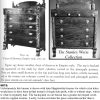This formidable case piece is defined in part by an elaborately scrolled backboard embellished with rosettes flanked by deeply carved columns and pineapples. This chest has four graduated drawers and a narrow split drawer, all of which is framed with elaborately carved columns of the best quality, similar to the pineapple columns above and the strongly carved paw feet below. The brasses are original and ring pulls with elaborate floral backplates successfully complete this piece.
This bureau is a tour de force of the skill of cabinetmakers and carvers that worked with the best materials available. It is the type of work produced by Michael Allison and a few contemporaries in New York. The development of style is cyclical in the nature of alternating elements. For example, more substantial curving forms give way to the use of clean lines in lighter furniture, in the transition from Chippendale (c.1760-1800) to Hepplewhite (c.1790-1810)—the above bureau of masculine quality is the harbinger of yet another reverse trend in the cycle toward the more substantial and seemingly important casepieces which typify the Empire movement in the first quarter of the nineteenth century.
For a related bureau, illustrated in Colonial Furniture in America, by Luke Vincent Lockwood, see below.
Height (w/o backsplash): 51 in. Overall Height: 64 1/2 in.
Case Width: 48 in. Overall Width: 48 1/2 in. Depth: 24 1/4 in.



























